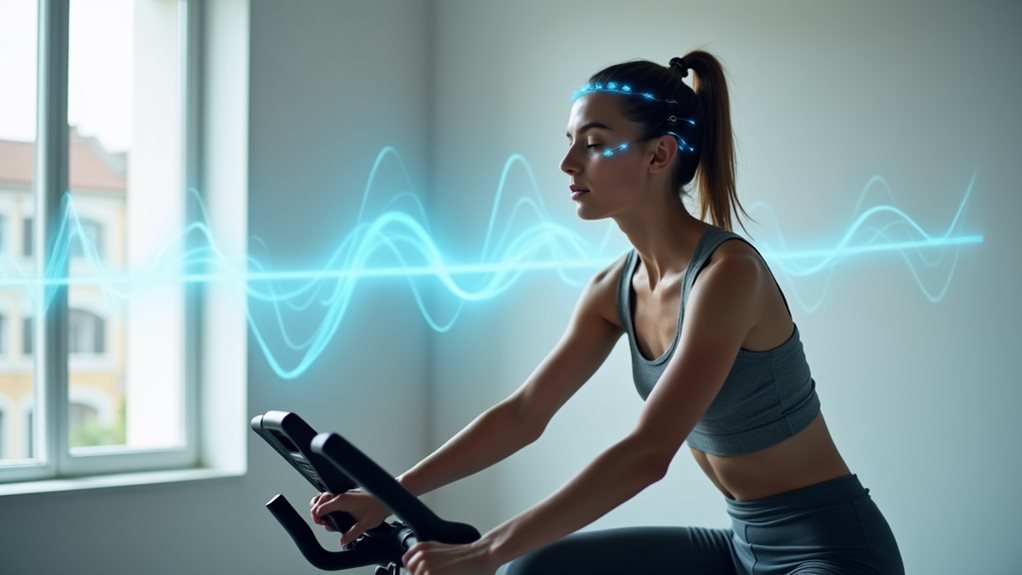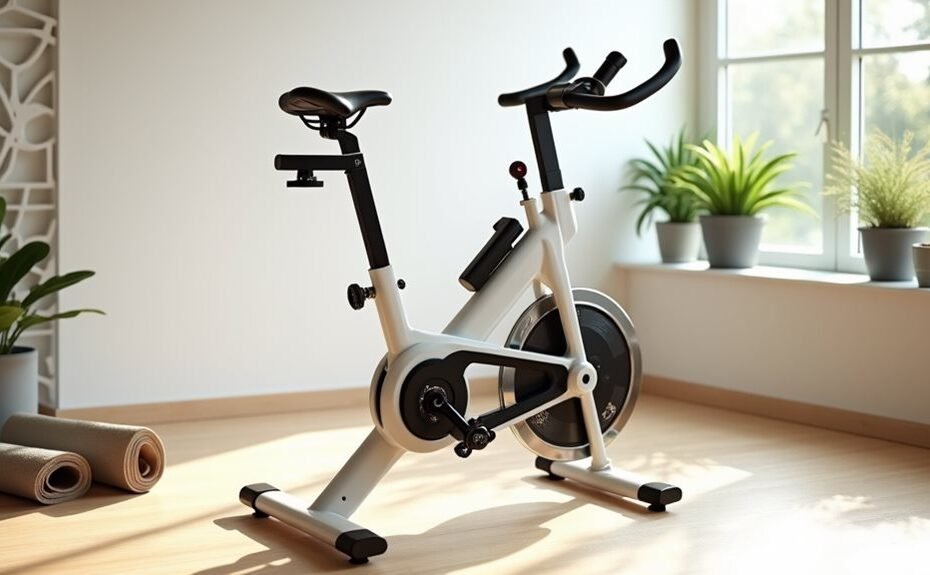When I first brought a static bike into my home office, I didn't expect it would transform both my workday and my mental health. Like many professionals juggling deadlines and stress, I'd struggled to find time for exercise and mindfulness. Now, I've discovered what neuroscience has been telling us: cycling, even in place, creates a powerful cocktail of mood-enhancing chemicals in our brains. As static bikes revolutionize mental fitness, they're offering more than just physical benefits – they're providing an accessible path to emotional resilience and cognitive clarity. The connection between pedaling and peace of mind runs deeper than you might think.
Key Takeaways
- Static bikes trigger the release of mood-enhancing chemicals like serotonin and dopamine, effectively combating stress and anxiety.
- Indoor cycling provides a consistent, weather-independent solution for maintaining mental fitness and stress management routines.
- Regular stationary cycling improves cognitive function through increased blood flow to the brain and enhanced neural connections.
- Static bikes offer customizable workouts that can be tailored to individual stress-relief needs from the comfort of home.
- The low-impact nature of static cycling makes it accessible for all fitness levels while delivering powerful mental health benefits.
The Science Behind Mental Wellness
While many people focus on the physical benefits of stationary cycling, the mental impact is equally profound. I'm here to break down exactly how your brain transforms when you hop on that bike – and trust me, the science is fascinating. Low-impact exercise like cycling supports overall cardiovascular health and mental well-being.
Let's start with the neurochemical fireworks. When you pedal for just 20-30 minutes, your brain floods with feel-good chemicals. I'm talking serotonin levels shooting up by 100-200%, dopamine surging through your system, and endorphins flowing like a river. You'll even produce anandamide, a natural cannabinoid that sedentary folks miss out on completely. The activity has proven to be as effective as therapy for managing depression and anxiety.
But here's where it gets really interesting: your cognitive function gets a serious upgrade. Blood rushes to your brain, literally feeding your neurons and sharpening your mental edge. Low-intensity rides have been shown to significantly boost attention and mental clarity.
I've seen the research – people consistently score higher on memory, reasoning, and planning tests after just 30 minutes of cycling. Your problem-solving skills improve, your reaction times quicken, and your concentration intensifies. It's like hitting the reset button on your brain's operating system, but better – because these improvements stick around with regular use.
Breaking Free From Depression

Now that we grasp the brain chemistry behind cycling, let's focus on its power to combat depression. I'll be blunt: exercise can match both psychotherapy and antidepressants in effectiveness. That's not just wishful thinking – it's science.
Here's what happens when you hop on that static bike: your brain starts pumping out serotonin and dopamine like a well-oiled machine. Just 20-30 minutes daily can prevent depression long-term – we've got 26 years of research backing this up. Stationary bike workouts can burn between 210-294 calories in a 30-minute moderate session, adding physical fitness benefits to mental health improvements. I'm talking about real, measurable changes in your brain chemistry.
Let's get practical. Start with 15-minute sessions. Don't overthink it. Your brain doesn't care if you're cycling outdoors or on a static bike – it's going to reward you with those mood-lifting chemicals either way. You can even adjust the intensity to match your energy levels and goals. And when you ride regularly, blood flow to the brain increases dramatically, enhancing your overall mental function.
The beauty of indoor cycling? You can do it regardless of weather, time, or energy level.
Think of each pedal stroke as a small victory over depression. You're not just burning calories; you're building mental resilience. Your body's keeping those stress hormones – adrenaline and cortisol – in check, while boosting your natural feel-good chemicals.
Cognitive Enhancement Through Exercise

Through countless studies, we've discovered that static cycling doesn't just lift your mood – it literally reshapes your brain. When you hop on that bike and start pedaling, you're not just burning calories; you're triggering a cascade of cognitive enhancements that'll make you sharper, smarter, and more mentally agile. Exercise bikes offer a convenient and accessible way to engage in this brain-boosting activity.
Exercise research shows that moderate intensity aerobic activities like cycling are especially effective for older adults. Studies reveal that purposeful exercise leads to improved brain function and reduced risk of mental decline.
Here's what happens when you make static cycling a regular part of your cognitive enhancement routine:
- Your hippocampus – the brain's memory center – actually grows in volume, boosting your ability to learn and remember
- Blood flow to your brain increases dramatically, delivering oxygen and nutrients that spark new neural connections
- Executive functions like planning, problem-solving, and working memory get a significant upgrade
I'll tell you straight: it takes commitment. You're looking at 150 minutes of moderate-intensity cycling per week to see real cognitive benefits. But here's the kicker – these improvements stick around as long as you keep pedaling. Stop, and you'll lose them. Think of it as a gym membership for your brain, where consistency is your ticket to lasting cognitive gains.
Your Brain On Cycling

Inside your brain, a remarkable chemical dance unfolds every time you climb onto a static bike. Your neurons fire up like a citywide party, pumping out serotonin at double or triple the normal rate. I'm not kidding – lab studies prove it. You're literally pedaling your way to a better-functioning brain.
Let me break down what's happening up there. While you're pushing through those resistance climbs, your brain's releasing dopamine (your reward chemical), endorphins (your natural painkillers), and even cannabinoids (yes, the feel-good stuff). It's like having a built-in pharmacy that activates with every pedal stroke. Indoor cycling helps you achieve better sleep quality naturally.
But here's the kicker – just 30 minutes on that bike sharpens your mental game significantly. You'll nail memory tests better. Your planning skills? Enhanced. That foggy thinking? Gone.
I've seen countless studies where people crush cognitive challenges after a cycling session. And if you're struggling with stress or anxiety? Those repetitive pedaling motions work like meditation in motion, clearing mental clutter while your brain builds new neural pathways.
Mental Health Without Weather Limits

Weather excuses vanish when you've got a static bike waiting at home. I'm here to tell you why that matters for your mental wellbeing. Indoor cycling isn't just about physical fitness – it's your all-season ticket to improved mental health.
Let me break down why consistent access to indoor cycling is a game-changer for your mind:
- You'll get those essential mood-boosting endorphins every single day, regardless of rain, snow, or scorching heat
- There's no "maybe tomorrow" when your bike's right there – this consistency is vital for managing anxiety and stress
- You can customize your mental health workout exactly how you need it, any time of day
I've seen countless clients transform their mental state through regular indoor cycling. It's simple: when you remove weather as a barrier, you're creating a dependable pathway to better mental health. Your brain doesn't care if it's storming outside – it just needs that steady dose of exercise-induced neurotransmitters. Think of your indoor bike as your personal mental health insurance policy, always there when you need it.
Frequently Asked Questions
How Long Should Beginners Cycle to See Improvements in Their Mental Health?
Want to boost your mental well-being? I recommend starting with 15-20 minutes of cycling, 3-5 days weekly. You'll notice improvements as you gradually increase to 30-45 minutes per session.
Can Indoor Cycling Help With Managing Panic Attacks and Anxiety Disorders?
I've found indoor cycling can help manage panic attacks and anxiety disorders by regulating stress hormones, releasing mood-lifting chemicals, and providing a calming, repetitive motion that helps control anxious thoughts.
Is Morning or Evening Cycling Better for Mental Health Benefits?
Like choosing between sunrise's fresh start and sunset's gentle release, I'd say both times work well, but morning cycling creates lasting mental benefits that ripple throughout your entire day.
What's the Ideal Resistance Setting for Stress Relief During Indoor Cycling?
I recommend setting your resistance at a low to moderate level where you can maintain steady pedaling for 20-30 minutes while still being able to breathe comfortably and feel challenged.
Should I Combine Indoor Cycling With Meditation for Enhanced Mental Benefits?
I'd strongly recommend combining indoor cycling with meditation – it's a powerful duo for mental wellness. You'll boost mood, reduce stress, and enhance cognitive function more effectively than either practice alone.
